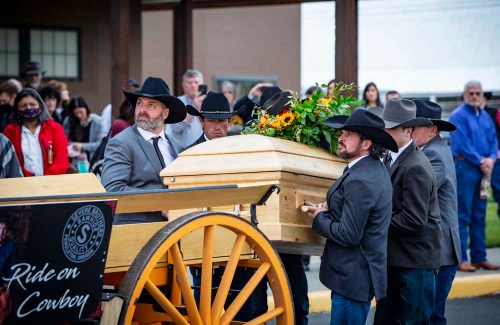2021 Year in Review: COVID-19 surges again, spikes from Round-Up
Published 5:00 am Friday, December 31, 2021

- Randy Severe’s sons Ryan Severe, left, and Jarad Severe look up as they lift their father’s casket atop a horse-drawn carriage Tuesday, Nov. 30, 2021, following his funeral service at the Pendleton Convention Center.
10) Mandates and protests
PENDLETON — Gov. Kate Brown on Aug. 19 issued an executive order mandating COVID-19 vaccinations for state employees, health care workers and school staff. Locals made their ire and concerns about the mandate public at protests and walkouts.
Trending
More than 150 people attended an anti-mandate rally Aug. 26 at Pendleton’s Roy Raley Park. The protest drew a multitude of voices, ranging from those completely rejecting vaccines and masks to those who were supportive of vaccines but felt the governor’s orders to either get the vaccine or lose their jobs violated their rights.
Jared Uselman, the president of the Pendleton Professional Firefighters IAAF Local 2296, said he was working on negotiations with the state over vaccination requirements when he was blindsided by the governor’s order.
“I don’t think that vaccination is wrong, I don’t oppose it by any means,” Uselman said. “But I do oppose people not having a choice.”
Workers had until Oct. 18 to get the shots or undergo frequent testing to keep their jobs.
The morning of Oct. 19, a group of health care workers at St. Anthony Hospital walked away from their jobs in protest of the testing requirement. St. Anthony reported placing 15 employees — or 4% of its more than 370 employees — on unpaid leave.
9) Schools reopen in the spring
Trending
UMATILLA COUNTY — While the surge of COVID-19 cases rose and fell throughout the pandemic, a major beam of hope was the reopening of public schools.
Going into the Oregon Department of Education’s latest update on its COVID-19 rules in March, Eastern Oregon administrators were looking for two things — reducing the social distancing requirement from 6 feet to 3 feet and removal of the cohort limit.
When the state made its announcement March 22, they got both.
The day after the state changed the rules, Hermiston School District sent out an announcement of its own — all students would resume full-time learning five days a week starting April 13.
Superintendent Tricia Mooney said the 6-foot requirement had been the thing holding the district back from offering full-time school sooner. Pendleton Superintendent Chris Fritsch said the district’s secondary schools will reopen as advertised, but the district needed until April 12 to formulate a plan based on the new rules.
Pendleton High School Principal Melissa Sandven said about 90% of Pendleton High School’s students were returning to in-person school, and as the school settled into its new routine, some of the teens who initially opted for online classes changed their mind.
Milton-Freewater and Athena-Weston school districts jumped to full days of in-person learning as well in April.
Another beloved outlet for students also returned — sports.
8) Delta variant arrives and sparks new calls for vaccinations
LA GRANDE — Oregon eased off its pandemic restrictions in early July regardless of infection and vaccination levels in individual counties. Some independent epidemiologists were concerned the move could lead to a spike in new cases in areas where most residents were not vaccinated.
Such as Eastern Oregon, where the vaccination rate in several counties was at no more than 40%.
Just as the state was reopening, Oregon also found it, too, was home to the most virulent form of the coronavirus to that point: the delta variant.
Oregon by mid-July reported 14 delta cases with three in Region 9, an area that encompasses Morrow, Umatilla, Union, Wallowa, Baker and Malheur counties.
The three were in Umatilla County, but experts reported that almost certainly was an undercount. Health care experts urged people to get vaccinated to stave off a blow up of delta infections that again would tax hospitals.
7 Athena woman spearheads vaccine efforts
ATHENA — As much as the pandemic was the story that affected all lives, it also has been a showcase of individual efforts to fight the virus.
Rachelle Lasater was at the forefront of COVID-19 vaccination efforts in some of Umatilla County’s smallest towns: Helix, Weston and Athena. Lasater in late summer estimated she vaccinated nearly 300 people. That was nearly 30% of all vaccinations in those three communities, according to county health data.
A registered nurse at East Umatilla Fire and Rescue and former employee of the Umatilla County Public Health Department, Lasater volunteered to bring vaccines to the towns in northeast Umatilla County, taking the reins from the health department in May.
Lasater traveled to people’s homes for appointments, providing immunizations and vaccine information. She’s spearheaded clinics at elementary schools, local pools and community halls, at times working alone or on her days off.
6) Big events return to in-person
UMATILLA COUNTY — Major summer events returned to Eastern Oregon even as local COVID-19 cases ramped up, but not without consequences.
Pendleton Whisky Music Fest on July 10 likely was the largest event Eastern Oregon has seen since the pandemic began, and while the showcase was smaller than in years past, organizers estimated that 12,000 people danced and drank the night away at the Pendleton Round-Up Grounds.
Whisky Fest co-manager Doug Corey said 12,000 attendees was the target, and headliner county artist Toby Keith was the main draw that helped make that happen.
The musical festival had long been a question mark, as the state remained under lockdown measures to curb the spread of COVID-19. And a workforce shortage created additional challenges to staffing, including finding security. But during the past month, Corey said the concert came together in a hurry, with much support from the community.
Afterward, the Oregon Health Authority announced it was investigating a COVID-19 outbreak of 41 cases stemming from the Pendleton Whisky Music Fest.
August marked the return of county fairs and local rodeos. 4-H and FFA youths showed their animals in person once again at the fairs in Umatilla and Morrow counties. Farm-City Pro Rodeo in Hermiston saw new arena records. All of that was a precursor to the Pendleton Round-Up.
5) Supplies and housing remain tight
PENDLETON — Throughout 2021, the COVID-19 pandemic took shots at everyday life, from protective face masks to the way we gather. Another major change was the supply chain shortage, as grocery stores, the housing market, food banks and more experienced the repercussions.
Customers witnessed empty shelves at grocery stores and reduced hours at local restaurants as workers elected to stay home. The supply chain backup had individuals concerned over sporadic shortages, from turkey on Thanksgiving to everyday household items.
Pendleton’s tight housing market grew tighter as well. Jef Farley, a real estate agent with Coldwell Banker Farley Co., said Pendleton had only about 10 houses available for sale in what’s considered a market that heavily favors sellers.
According to the U.S. Census Bureau, more than half of Pendleton workers don’t reside in the community, a fact city officials have used to argue that more people would live in town if the housing market weren’t so tight, and 2021 started to show breakthroughs in developments.
Wildflower Apartments, an affordable housing development, is going up on Southwest 18th Street near Olney Cemetery, and the nonprofit Horizon Project is proceeding with South Hill Commons, a 70-unit affordable apartment complex on the east side of South Hill.
The supply chain woes reached local schools, where students’ lunches saw an impact. Those issues prompted state leaders with the Oregon Department of Education to issue temporary waivers for schools for nutritional requirements.
During fire season, a jet fuel shortage raised concern over possible danger in the case of a large wildfire. Airport officials lacked the necessary fuel as demand saw a major increase in the wildfire season.
4) Federal COVID-19 relief money benefits local governments
WASHINGTON — The $1.9 trillion American Rescue Plan Act was trickle-down stimulus that sent millions of dollars into states and local economies staggering under the weight of the pandemic.
In Oregon, that amounted to just more than $4.26 billion — the state got $2.62 billion, counties received $818 million, larger cities got $438 million, and other communities received $243 million.
Umatilla County received $15.12 million while $2.25 million went to Morrow County. Hermiston received $3.62 million, Pendleton $3.42 million while $230,000 went to Athena and $260,000 to Heppner.
The plan also provided $118 million to hospitals and health care providers across Oregon serving rural populations. The Center for Human Development, La Grande, and Wallowa County Health Care District, Enterprise, were among the recipients.
Schools benefited as well.
Elementary and Secondary School Emergency Relief under ARP allowed the Hermiston School District, for example, to cover school supplies for students.
3) Where are the workers?
HERMISTON — No industry was hit harder by the continuing pandemic than the restaurant industry. But even still, other sectors of the economy bore the struggles of the virus all the same, albeit in different ways. And as the pandemic seemed to wane, with large sections of the entertainment industry opening its shuttered doors, a new problem arose.
There simply were not enough workers.
Myriad reasons came forth why hiring slowed or seemingly stopped altogether. Economists posited that fears of the virus itself, child care and pay were among the reasons why positions lay unfilled as demand for services skyrocketed. Others reasoned the elephant in the room — unemployment benefits, were the sole cause of the labor shortage.
EO Media Group put out an ambitious effort over the summer to find the truth behind the worker shortages.
Our findings echoed sentiment from both camps. Employers gave testimony of how potential employees would hand in resumes solely to fulfill a requirement that allowed them to keep collecting unemployment benefits.
“We get a lot of random resumes dropped off, which I guess is people trying to satisfy job-search requirements,” said Jared Hillock, a manager and co-owner of Hillock Electric in Enterprise.
A rapidly changing demographic compounded the shortage, the boomers retiring at a faster pace due in part to the continuing pandemic.
Soon, labor shortages in key industries mixed with higher gas prices led to yet another shortage — supply chains were in disarray as store shelves and consumptive goods arrived late, or not at all.
2) Round-Up returns, but business was slower
PENDLETON — Pendleton Round-Up and local government officials were signaling the biggest show in Eastern Oregon would go on in 2021. But local and state officials raised red flags about the possibility of an outbreak.
The Confederated Tribes of Umatilla Indian Reservation Board of Trustees on Aug. 26 videoconferenced with the Round-Up Board of Directors to discuss the rodeo’s health and safety measures as the former contemplated taking an official position on this year’s event. Trustees expressed their concerns the Round-Up needed to do more to curb coronavirus spread was not enough.
Gov. Kate Brown declared on Aug. 27 that masking up would be a requirement of outdoor events where social distancing isn’t possible.
The crowd indeed came in September to the Pendleton Round-Up, but it was smaller than in the years before the pandemic and economic boom that comes with the Round-Up was smaller.
Joe’s Fiesta Mexican Restaurant owner Joe Meda said he decided to take off Round-Up so he wouldn’t have to worry about enforcing the mask mandate, especially because many potential customers come from states where there are no face covering rules.
Great Pacific kept its 403 S. Main St. restaurant open during Round-Up week, and while the restaurant did see a boost, manager Addison Schulberg said the crowds were smaller than in years past. He also said getting people to comply with mandates was one of GP’s consistent hurdles.
Hotels seemed as busy as ever during Round-Up week, but vendors said results were mixed. Through Thursday of Round-Up week, Main Street vendors were reporting lower than average business but hoping for an uptick on the final two days of the rodeo.
The Round-Up did little to enforce the governor’s mask mandate. Health data linked at least 247 COVID-19 cases to the week-long rodeo.
1) People lost to COVID-19
UMATILLA COUNTY — 2020 was Umatilla County’s first year under the pandemic, but it exacted a much higher toll in 2021.
As of Wednesday, Dec. 29, Umatilla County recorded 122 deaths related to COVID-19 in 2021, bringing the county’s total death count to 187. But in the early months of the year, there were reasons for optimism. After 19 COVID-19 deaths were reported in January, the county reported low single-digit totals in the six months that followed.
But the delta variant reversed that trend. From August through October, the number of Umatilla County residents who died with COVID-19 exceeded the entire death county from 2020: 68 versus 65.
If there was a silver lining to 2021, it’s that Umatilla County’s COVID-19 death rate remained below average. Only 1.2% of reported COVID-19 cases resulted in death, a number below the state’s 1.4% rate and far better than many of Umatilla County’s rural counterparts.
But numbers don’t fully illustrate the loss felt by residents who lost family and friends to the virus.
The casket bearing the body of Randy Severe, a popular saddlemaker and former Round-Up president, was led through the streets of Pendleton in late November after Severe died after a COVID-19 diagnosis.
The Aug. 7 death of Michael Gavin spurred two ceremonies: one at the Mission Longhouse to honor his tribal heritage and another at the Bethel Church, where he had served as a youth pastor.
“While I’m so happy that our death toll has been lower than most reservations, people can get lost in the numbers and not realize that every single one of those numbers is a tragedy for some family,” his sister, Jill-Marie Gavin, said at the time.









